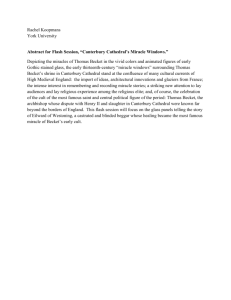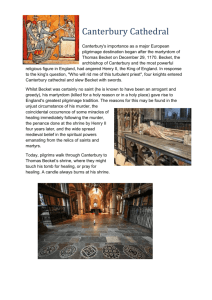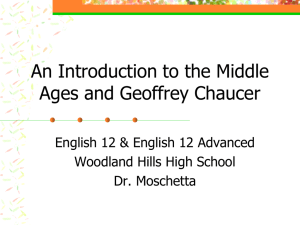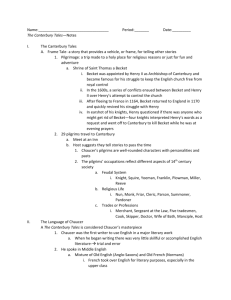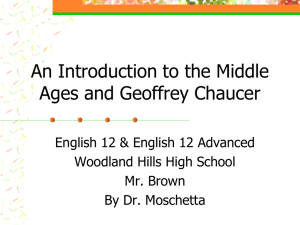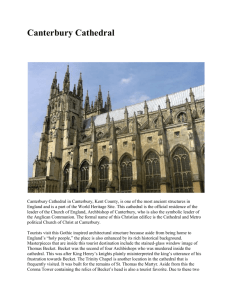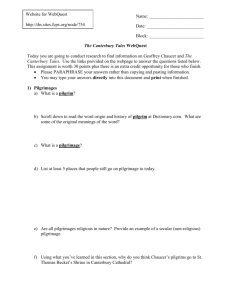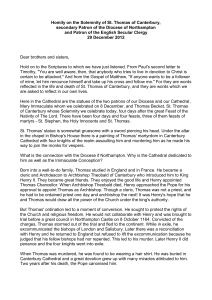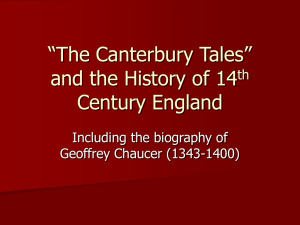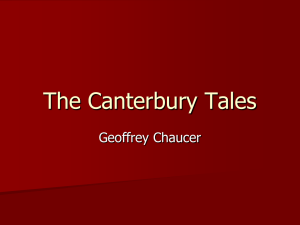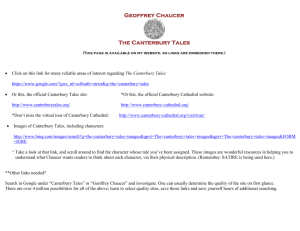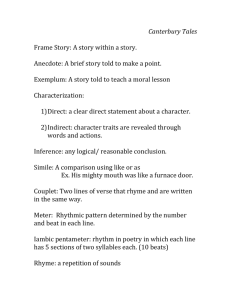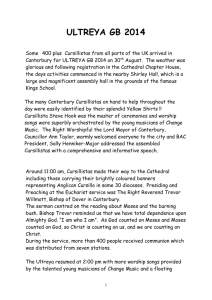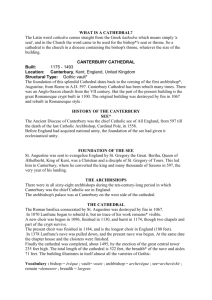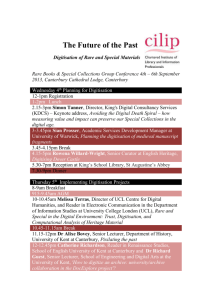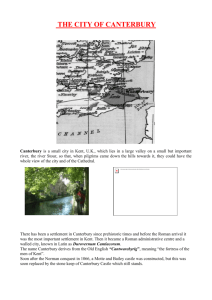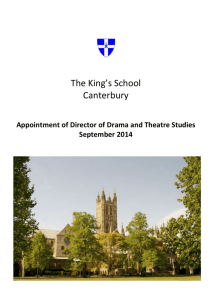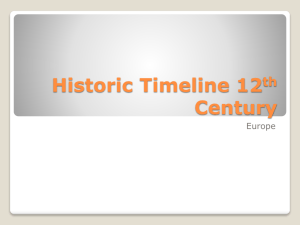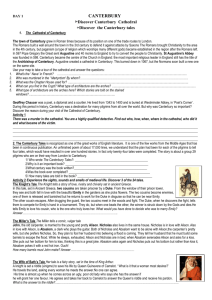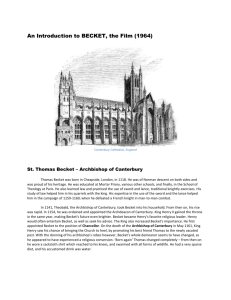Lesson planRowley
advertisement
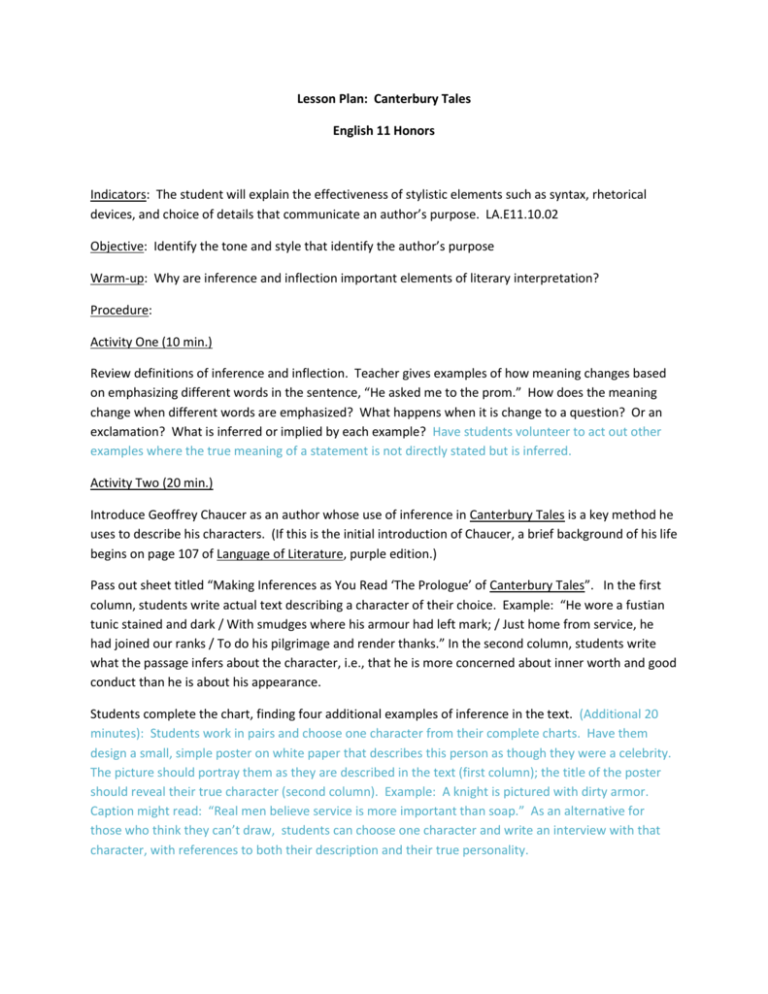
Lesson Plan: Canterbury Tales English 11 Honors Indicators: The student will explain the effectiveness of stylistic elements such as syntax, rhetorical devices, and choice of details that communicate an author’s purpose. LA.E11.10.02 Objective: Identify the tone and style that identify the author’s purpose Warm-up: Why are inference and inflection important elements of literary interpretation? Procedure: Activity One (10 min.) Review definitions of inference and inflection. Teacher gives examples of how meaning changes based on emphasizing different words in the sentence, “He asked me to the prom.” How does the meaning change when different words are emphasized? What happens when it is change to a question? Or an exclamation? What is inferred or implied by each example? Have students volunteer to act out other examples where the true meaning of a statement is not directly stated but is inferred. Activity Two (20 min.) Introduce Geoffrey Chaucer as an author whose use of inference in Canterbury Tales is a key method he uses to describe his characters. (If this is the initial introduction of Chaucer, a brief background of his life begins on page 107 of Language of Literature, purple edition.) Pass out sheet titled “Making Inferences as You Read ‘The Prologue’ of Canterbury Tales”. In the first column, students write actual text describing a character of their choice. Example: “He wore a fustian tunic stained and dark / With smudges where his armour had left mark; / Just home from service, he had joined our ranks / To do his pilgrimage and render thanks.” In the second column, students write what the passage infers about the character, i.e., that he is more concerned about inner worth and good conduct than he is about his appearance. Students complete the chart, finding four additional examples of inference in the text. (Additional 20 minutes): Students work in pairs and choose one character from their complete charts. Have them design a small, simple poster on white paper that describes this person as though they were a celebrity. The picture should portray them as they are described in the text (first column); the title of the poster should reveal their true character (second column). Example: A knight is pictured with dirty armor. Caption might read: “Real men believe service is more important than soap.” As an alternative for those who think they can’t draw, students can choose one character and write an interview with that character, with references to both their description and their true personality. Activity Three (5 min.) Discussion: How do you think Chaucer feels about his characters? How do you think he wants you to feel about them? Why do you think he uses inference to describe them, rather than just telling us what they are really like? Activity Four (20 min.) As students are posting their posters and interviews around the room, project an image of Canterbury Cathedral on the screen. Playing cathedral organ music in the background would also help set the stage. Ask students what personality traits they consider in another person before trusting them. How do they know who is trustworthy and who isn’t? How long does it take to know a person’s true character? Have they ever had an experience when they thought they could trust someone and later found out they were wrong? How did they feel about it? Introduce and tell the story of “The Murder in the Cathedral,” in which Thomas Becket was killed by the knights of Henry II. Students need to understand this event in order to know that the pilgrims are travelling to Canterbury Cathedral to worship at Becket’s shrine. A brief summary of this event is on p. 110 of Language of Literature, purple edition. Scenes inside the cathedral, including the place Becket was murdered, can be found online. Show several as the story progresses. Summary (10 min.) In response journals, have students answer the following questions: What is inference? How does it help create the author’s tone and message to the reader? How does it connect with the statement, “Things are not always what they seem to be”? Reflection: With these additions, the lesson will appeal to almost every type of learning style/intelligence. With the Primacy Recency effect in mind, I placed the most important concepts of the lesson at the beginning and end, plus changed activities and/or teaching methods about the time that attention would begin to lag. I think the varied methods will simplify understanding, aid comprehension through more interesting and relevant teaching, and hopefully give students something interesting to remember.

